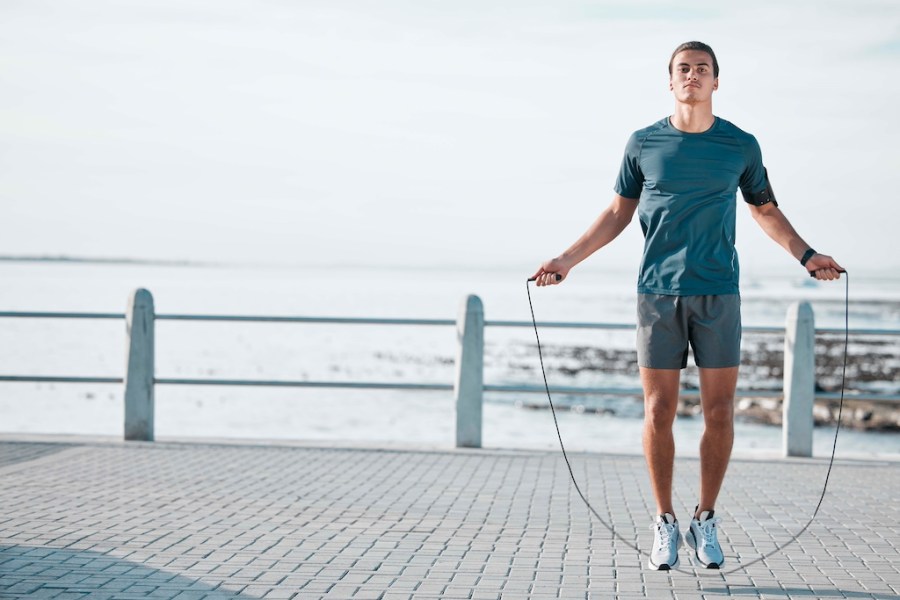Skipping is more than a throwback; done right, it offers a number of serious health benefits, in a budget-friendly and convenient formula that can be done virtually anywhere.
Skipping is more than just a playground pastime; it’s a versatile and effective workout that’s stood the test of time. From ancient practices to modern-day fitness routines, from double dutch skipping to Egyptians reportedly using vines to jump, its history is rich and varied.
More recently, the rise of high-intensity interval training and CrossFit have boosted the popularity of skipping. It’s a standard element in numerous workouts, and in the recent CrossFit Open 216,926 athletes completed over 100 double-unders each. But whether you’re a rookie or a returnee to the skipping game, you don’t need a boxer’s finesse to unlock its fitness advantages.
Put a spring in your step
Skipping is a powerhouse activity for cardio fitness, and it’s proven to reduce the risk of cardiovascular diseases. Remarkably, one study found that a ten-minute skipping session can enhance cardiovascular efficiency as much as a 30-minute jog.
Far from being just child’s play, skipping is a full-body workout that targets your arm, shoulder, and leg muscles. Its affordability and versatility make it an excellent option. One review even highlighted its benefits as you age, with three weekly skipping sessions able to significantly improve strength in those over 50.
According to functional fitness coach Tom Cuff-Burnett, skipping provides a lower-impact alternative to running. “When done properly, the light, repetitive movements of skipping put less pressure on your knees than pounding the pavement, thus reducing the risk of ankle/knee injuries and shin splints.” This makes it an appealing option for those looking to protect their joints while still getting a high-intensity workout.
Represent 247 Athlete Victor Hoffer incorporates skipping into his fitness regimen because “it’s like a two-for-one fitness deal which gets your heart pumping and your body moving in sync.” He highlights that skipping is not just a workout, but a skill that can elevate your fitness game. “You don’t even need a fancy gym membership to get in on the action – just grab one of the best skipping ropes,” he adds.
Skipping isn’t just great for your body, either. While it forces you to maintain good posture, standing straight with your shoulders back, the mental engagement required for skipping – focusing on timing, rhythm, and coordination – can enhance cognitive performance and reduce anxiety.
Patient progress
Skipping might look simple, but mastering it requires patience and dedication. Whether you’re a newbie or dusting off an old skill, performing it fluidly will take some time and effort.
Begin with short, manageable workouts. The high intensity of skipping can be both physically tiring and potentially frustrating when you’re trying to advance quickly. “Be patient with yourself,” advises Cuff-Burnett. “Pay attention to how your body feels during and after skipping sessions, and allow yourself time to rest and recover. Celebrate small wins and milestones along the way – perseverance is key to long-term success.”
He also emphasises the importance of consistency: “Skipping regularly, even for short periods, can significantly improve your skills and endurance. Aim to practice at least three to four times weekly to see steady progress.”
Setting specific and achievable goals can keep you motivated and on track. Whether you want to increase your endurance, enhance your speed, or master a new move, having clear objectives will help you stay focused. “Set goals like increasing the duration of your skips or introducing advanced moves like double-unders,” adds Cuff-Burnett.
And good form is crucial to avoiding injury and making the most of your workouts. “Maintain proper posture, keep your core engaged, and land softly on the balls of your feet to minimise impact,” Cuff-Burnett advises. This focus on technique will help you reduce the risk of injuries and ensure that each session is effective.
Remember, progress in skipping takes time, but with patience and consistency, you’ll see significant improvements.
How to progress to double-unders
Once you’ve mastered the skipping basics, here are some tips for progressing to a double-under, a notoriously tricky skipping move where the rope passes under your feet twice in every jump. Think coordination, agility, balance and speed.
Hoffer agrees that you need to perfect single skips first, and ensure you stay in one spot and jump efficiently. He says, “Next, focus on jumping higher than usual, as you’ll need to get the rope around your body twice for a double-under. Once you’ve got that down, start integrating double-under attempts.
“Begin by mixing in one double-under with some single-unders, like five single skips followed by one double-under, and repeat. Once you’re comfortable with that, try doing two double-unders between single skips, gradually adding more reps until you’re smoothly chaining together double-unders in larger sets.”
How to make your skipping technique more efficient
- Hold the handles with a firm grip, keep your elbows close to your sides, and use your wrists to rotate the rope
- Establish a good rhythm. Jump just high enough to clear the rope and focus on landing softly on the balls of your feet
- Keep your shoulders relaxed and don’t tense up. This will help you maintain a smooth and efficient motion
- Consider recording yourself or have someone watch you skip to provide feedback on your form
10 ways skipping benefits body and mind
- Cardio fitness: Skipping is a highly effective aerobic exercise that boosts heart health, improves circulation, and enhances cardiovascular endurance.
- Calorie burning: Skipping burns a significant amount of calories in a short time, making it an efficient workout for weight management and fat loss.
- Improved coordination and agility: Regular skipping sessions help enhance coordination, balance, and overall agility, making it beneficial for various sports and activities.
- Bone strength: The impact of skipping helps in strengthening bones, which can reduce the risk of osteoporosis and improve bone density.
- Full-body workout: Skipping engages multiple muscle groups, providing a comprehensive workout for the arms, shoulders, core and legs.
- Enhanced respiratory health: It promotes better respiratory function by increasing lung capacity and strengthening the respiratory muscles.
- Endurance building: Regular skipping routines improve stamina and endurance levels, allowing individuals to perform better in physical activities.
- Stress relief: Skipping can serve as a stress-relieving exercise, releasing endorphins and reducing anxiety and stress levels.
- Cost-effective and portable: It’s a convenient and cost-effective workout option that can be done anytime, anywhere, requiring minimal equipment.
- Brain health: The coordination and focus required during skipping can improve cognitive function, memory and concentration.

Try this skipping workout for beginners
Tom Cuff-Burnett’s simple skipping workout for beginners.
Warm-up (5 mins)
- Begin by jogging on the spot or engaging in high knees, heel flicks, and star jumps to elevate your heart rate. Incorporate a few practice jumps to ease into the rhythm
Dynamic stretching and mobilisation (3 mins)
- Dedicate a few minutes to dynamic stretches for your legs and shoulders, aiding in flexibility. To mobilise the spine and prep your back muscles, introduce rotational exercises
Workout (approx. 25 mins)
- Basic two-footed jump (1 min)
Kick off with the fundamental two-footed jump. Focus on maintaining a consistent rhythm as you find your flow. - Alternate footstep (1 min)Transition to skipping on each foot alternately as the rope passes beneath you. This variation hones coordination and agility.
- Rest (60 secs)
Take a breather and reset for the next round. - Progressive rounds
- Round 2 (2 mins skipping, 90 secs rest)
- Round 3 (3 mins skipping, 2 mins rest)
- Round 4 (4 mins skipping, 2:30 rest)
- Round 5 (5 mins skipping, concluding the progression)
- Freestyle segment (2 mins)
In the final push, get more creative with freestyle jumps and combinations. Explore new movements, challenge yourself, and inject fun into your routine.
Cool-down (5 mins)
- Conclude with five minutes of static stretching, prioritising the calves, hamstrings, quads and shoulders







